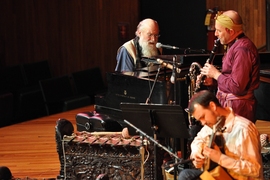Now in its eighth year, 2019-20 MIT Sounding presents another season of wide-ranging musical offerings that have found a vibrant home at MIT.
“The program feeds the hunger of a diverse audience for music at MIT,” says Evan Ziporyn, faculty director of the MIT Center for Art, Science and Technology (CAST) and curator of the series. “We try to give students a sense of exploration, while also developing a larger-scale dialogue with local audiences.”
The eclectic journey continues with Boston premieres of music from New York, Czechia, and Nepal, as well as returning artists who have wowed local audiences and who continue to push new musical boundaries. Add a septet of turntable artists, a multimedia score by Tod Machover, and a virtual reality-enhanced, dataset-driven “space opera” by artist Matthew Ritchie, and you have an abundant season of MIT Sounding.
Glenn Branca: New York’s enfant terrible
The year started with a bang with “Branca Lives: The Glenn Branca Ensemble/Ambient Orchestra," an all-too-rare performance of music by the proto-punk legend, who passed away in 2018.
“Branca’s symphonies for multiple guitars — sometimes up to 100 at a time — were Brutalism in musical form,” says Ziporyn. “He embraced the energy of noise, distortion, and feedback, but in a carefully organized way, activating overtones and microtones to create amazing, almost hallucinogenic textures. He was thinking orchestrally, building out from the sound of the electric guitar rather than from classical instruments. Then he began to write for acoustic orchestra and found ways to get the same effects.”
“Branca Lives" presents the composer’s eponymous guitar ensemble, led by his longtime concertmaster and collaborator, Reg Bloor. Their set will include Branca’s “The Light (for David),” a tribute to David Bowie. Ziporyn and the Ambient Orchestra will open the concert with Boston premieres of two of Branca’s rarely performed orchestral works — “Symphony No. 14 (2,000,000,000 Light Years from Home)” and “Freeform.”
“It’s brilliant and surprising music that deserves to be known,” adds Ziporyn.
Lochan Rijal shares music of Nepal
Despite an ever-shrinking global culture, many musical traditions remain overlooked, including the music of Nepal. “काँचो आवाज (Raw Sounds),” a program that celebrates Nepal’s unique musical heritage, seeks to address that oversight.
“काँचो आवाज (Raw Sounds)” features Lochan Rijal, the award-winning Nepali multi-instrumentalist singer and songwriter, performing new and traditional compositions based on his own musical narrative of everyday life in Nepal. The head of Kathmandu University’s Department of Music, Rijal will play the sarangi, a traditional short-necked fiddle, and the Gandharva lute arbaja, recently discovered in Rijal’s research in Nepal.
During his residency, Rijal will discuss a temple restoration project and Nepal’s musical traditions in a public lecture.
Iva Bittová with MITSO
Legendary Czech vocalist/violinist Iva Bittová is a familiar force of nature at MIT, having performed with the improvisational trio EVIYAN, and collaborated with the Festival Jazz Ensemble and Pilobolus Dance for MIT One World.
Bittová returns this October as composer to launch the MIT Symphony Orchestra’s (MITSO) 2019-20 season in “The Heart is a Bell.” The concert pairs two pieces by 20th century Czech female composers: Bittová’s “Zvon” and Vítězslava Kapralova’s “Suita Rustica.” Composed 75 years apart, both works draw on Czech and Slovak folk culture, seen through a modern lens.
At once personal and avant-garde, “Zvon” features Bittova’s voice, jazz combo, elements of world music and cabaret, and improvisation by members of the orchestra. “We’re widening the orchestral landscape,” says Ziporyn, who steps in as acting MITSO director this academic year.
Additional projects and performances
What happens when seven DJs gather, challenged to make music together rather than as solo acts? Audiences will find out this January, in “the wave function collapses.” The unique program features harbanger (pronounced “harbinger”), a turntable septet with visiting artists Harry Allen and DJ Rob Swift, known for their work with Public Enemy and The Source magazine. “The wave function collapses” is the culmination of a two-week workshop facilitated by Eran Egozy, professor of the practice in music technology at MIT and co-founder and CTO of Harmonix Music Systems. The 2020 Independent Activities Period (IAP) offering includes two courses: a history of DJ culture by hip hop activist and “Media Assassin” Harry Allen, and hands-on DJ instruction by DJ Rob Swift.
Virtuoso violinist Johnny Gandelsman performed Johann Sebastian Bach’s "Sonatas and Partitas" as part of MIT Sounding’s 2015 season. The adventurous soloist returns this spring to perform “Bach’s Cello Suites” on the violin — which can be challenging, given the two instruments’ very different voicings. But this isn’t reinvention for its own sake, says Ziporyn. It’s simply “to get the most from the music, in an enthralling way.”
This March brings composer Tod Machover’s "City Symphonies" to Boston for the first time. Rich in visuals and sense of place, “Moving Images: MITSO and Film” is part of the MIT Symphony Orchestra’s 2019-20 season. “It’s time to present this music on Tod’s home turf,” notes Ziporyn, who will conduct the ensemble. Audiences can expect a unique evening of music and film, including work developed by Machover and his team in the Opera of the Future group at the MIT Media Lab.
The season closes with a new transmedia work, “The Invisible College,” created by 2018–20 Dasha Zhukova Distinguished Visiting Artist Matthew Ritchie. The project refers to the multitude of interactions and collaborations that take place behind the scenes within the university, and brings together a multidisciplinary team of MIT artists, faculty, and students. Based on datasets representing scales of the universe — from nanoparticles to dark energy — “The Invisible College” encompasses a site-specific installation, virtual reality experience, and a May “Dark Energy: A Space Opera,” a collaboration between Ritchie, Ziporyn, and Christine Southworth.










